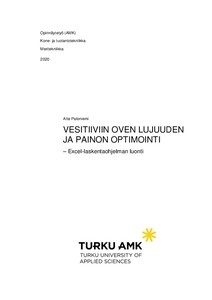Vesitiiviin oven lujuuden ja painon optimointi
Paloniemi, Atte (2020)
Paloniemi, Atte
2020
All rights reserved. This publication is copyrighted. You may download, display and print it for Your own personal use. Commercial use is prohibited.
Julkaisun pysyvä osoite on
https://urn.fi/URN:NBN:fi:amk-202005067382
https://urn.fi/URN:NBN:fi:amk-202005067382
Tiivistelmä
Tämän työn tarkoituksena on tarkastella vesitiiviitä ovia koskevia sääntöjä ja päivittää oven rakenteeseen liittyviä lujuuslaskelmia Tebul Oy:lle. Sääntöjä haluttiin tarkastella erikseen matkustaja-aluksille ja jahdeille. Näihin sääntöihin pohjautuen haluttiin luoda laskentaohjelmisto, jolla oven jäykkyyttä ja painoa saataisiin optimoitua, koska tällä hetkellä Tebul Oy:n vesitiiviit ovet ovat kilpailijoitaan painavimpia ja kalliimpia.
Työssä tarkasteltiin vesitiiviitä ovia koskevia säännöstöjä ja lisäksi tarkemmin kahden yleisesti käytetyn luokituslaitoksen vesitiiviiden ovien lujuutta koskevia laskukaavoja. Sääntöjä vertailtiin keskenään ja huomattiin, että sääntöjen vaatimustasossa oli eroja. Vaativammat laskentakaavat valittiin laskentaohjelman perustaksi. Myös vesitiiviin oven rakennetta tarkasteltiin ja pohdittiin mahdollisia kehityskohteita. Oven rakenteen kehityskohteita olivat jäykkääjissä käytetty profiili ja materiaali sekä keskipalkin yksinkertaistaminen. Laskentaohjelmalla laskettuja tuloksia vertailtiin vanhan laskentakaavion tuloksiin ja huomattiin, että oven rakennetta on mahdollista keventää huomattavasti. Laskentaohjelmalla voidaan helposti vertailla erilaisia rakennevaihtoehtoja ja niiden vaikutusta lujuuteen. The objective of this thesis was to review the rules for watertight doors and update the strength calculations for the door structure for Tebul Oy. The aim was to review the rules separately for passenger ships and yachts. Based on these rules, the aim was to create a calculation software that could be used for optimizing the stiffness and weight of the door. Currently Tebul Oy’s watertight doors are heavier and more expensive than their competitors.
The thesis examines the regulations for watertight doors, as well as the calculation formulas for the strength of watertight doors of two commonly used classification societies. The rules were compared with each other and it was found that there were differences in the level of requirements of the rules. More demanding calculation formulas were chosen as the basis for the calculation software. The structure of the watertight door was examined as well and possible areas for development were considered. The development of the door structure included the profile and material used in the stiffeners and the simplification of the center beam. The results calculated with the calculation software were compared with the results of the old calculation chart and it was found that it is possible to significantly lighten the structure of the door. The calculation software can be used to easily compare different construction options and their effect on strength.
Työssä tarkasteltiin vesitiiviitä ovia koskevia säännöstöjä ja lisäksi tarkemmin kahden yleisesti käytetyn luokituslaitoksen vesitiiviiden ovien lujuutta koskevia laskukaavoja. Sääntöjä vertailtiin keskenään ja huomattiin, että sääntöjen vaatimustasossa oli eroja. Vaativammat laskentakaavat valittiin laskentaohjelman perustaksi. Myös vesitiiviin oven rakennetta tarkasteltiin ja pohdittiin mahdollisia kehityskohteita. Oven rakenteen kehityskohteita olivat jäykkääjissä käytetty profiili ja materiaali sekä keskipalkin yksinkertaistaminen. Laskentaohjelmalla laskettuja tuloksia vertailtiin vanhan laskentakaavion tuloksiin ja huomattiin, että oven rakennetta on mahdollista keventää huomattavasti. Laskentaohjelmalla voidaan helposti vertailla erilaisia rakennevaihtoehtoja ja niiden vaikutusta lujuuteen.
The thesis examines the regulations for watertight doors, as well as the calculation formulas for the strength of watertight doors of two commonly used classification societies. The rules were compared with each other and it was found that there were differences in the level of requirements of the rules. More demanding calculation formulas were chosen as the basis for the calculation software. The structure of the watertight door was examined as well and possible areas for development were considered. The development of the door structure included the profile and material used in the stiffeners and the simplification of the center beam. The results calculated with the calculation software were compared with the results of the old calculation chart and it was found that it is possible to significantly lighten the structure of the door. The calculation software can be used to easily compare different construction options and their effect on strength.
